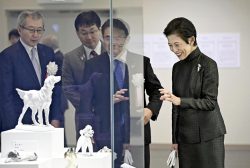
Chen Xi, right, and other trainees learn about design techniques from Kazuo Yamagishi, left, a living national treasure and chief instructor at the Ishikawa Prefectural Wajima Institute of Lacquer Arts.
11:13 JST, November 17, 2022
An increasing number of non-Japanese are training in traditional Japanese crafts such as lacquerware and ceramics. Chinese exchange students number among the overseas enthusiasts keen to learn craft-related skills in various parts of Japan.
The transfer of know-how facilitates the international division of labor within the craft industry, but the sharing of designs and advanced techniques is giving rise to conflicts of interest within the industry.
Ishikawa Prefectural Wajima Institute of Lacquer Arts accepts non-Japanese students. The institute, located in Wajima — a renowned production base for high-quality lacquerware — has a primary goal of producing the next generation of living national treasures in the lacquerware field.
This summer, four general training-course students, including two Chinese, attended a lesson by Kazuo Yamagishi, 68, a senior instructor of chinkin, a lacquerware technique to inlay gold. They attentively listened as Yamagishi — a designated living national treasure — offered advice on creating designs based on one’s own sensibilities, while incorporating seasonal elements and Japanese classical literature, such as waka poems.
The institute was established in 1967 to pass on the skills and techniques of living national treasures designated under the Law for the Protection of Cultural Properties. The three-year general training course requires no registration or tuition fees, and nine living national treasures serve as chief instructors.
This fiscal year, the government subsidized the course to the tune of ¥25.1 million, limiting students’ expenses to training materials alone.
Currently, the course has 16 students, including three Chinese. “I’m grateful to be learning here, not only about [craft-related] techniques, but Japanese culture, too,” said 31-year-old Chen Xi, a third-year chinkin student. “In the future, I’d like to become a lacquerware artist.”
According to the institute, it does not actively solicit overseas students, but has in recent years received a growing number of inquiries from Chinese and other non-Japanese who have learned about the training courses via the institute’s website. Since 1993, seven Chinese students have graduated from the school.
Nobuo Iwanami, head of the institute’s educational affairs section, said: “Due to the impact of the novel coronavirus pandemic, we’ve had fewer Chinese applicants since the 2020 academic year. Before that, the number was on an upward trend. If the pandemic hadn’t occurred, we’d likely have had an even higher number of [Chinese applicants].”
More and more Chinese students are studying lacquerware and ceramics at Japanese art universities and similar institutions, then becoming teachers and artists after returning to their homeland.
In a related development within the Japanese craft industry, some production bases are failing to maintain their traditional multi-step, division-of-labor system because they cannot secure replacements for retiring elderly workers involved in the various processes. As a result, most of the processes are carried out at Chinese production bases — where labor costs are lower — in conjunction with technical training.
Ohi Chozaemon XI, a renowned potter from Kanazawa, says that in Jingdezhen and other ceramic production bases in China, he has often seen plates and other ceramic pieces that seem to be imitations of Japanese Arita, Imari and Kutani ware.
Ohi, 64, who has been making business trips to China for the past 10 years, said: “The [works] aren’t of high quality in terms of technique, they merely imitate [different] styles. The prices are high considering commodity prices in China. Judging from their appearance and quality, they were probably made by craftspeople who are part of the international division-of-labor system working on behalf of the Japanese craft industry.”
For Japanese crafts to survive outside Japan, Japanese need to reaffirm the country’s unique culture, according to Imaizumi Imaemon XIV, a living national treasure of multi-colored porcelain from Arita, Saga Prefecture.
“In this age of globalization, transferring technology across borders is only natural,” said Imaizumi, 59. “It’s even possible that China will surpass Japan in the field, after learning techniques from Japan. To survive, we may have no alternative but to further refine Japan’s unique modes of expression based on our views of nature and culture, which are often perceived differently by Chinese.”
Kazumi Murose, 71, a living national treasure of makie lacquerware who lives in Tokyo, said: “Even if traditional techniques are transferred overseas, it’s vitally important to enhance within Japan the passing down of traditional skills that outstrip those techniques. But the government’s support for nurturing next-generation craftspeople continues to fall short. Looking ahead, we need more aggressive budgetary measures to train people who can play a major role within the industry in Japan.”
"Culture" POPULAR ARTICLE
-

Van Cleef & Arpels Dazzles with Art Deco Artisanry at Tokyo Exhibit
-

Disney’s ‘Twisted-Wonderland’ Animated Series Puts Villains in Spotlight: New Show Features School Inspired by Classic Disney Films
-

Japan Plans to Distribute Manga Overseas Via New Platform
-

Ayumi Hamasaki’s Shanghai Concert Canceled Day Before Schedule as Part of Beijing Backlash
-

‘The World Masterpiece Theater Series’ Celebrates 50 Years; Animator Looks Back on Creating Anime Classics
JN ACCESS RANKING
-

Tokyo Economic Security Forum to Hold Inaugural Meeting Amid Tense Global Environment
-

Keidanren Chairman Yoshinobu Tsutsui Visits Kashiwazaki-Kariwa Nuclear Power Plant; Inspects New Emergency Safety System
-

Imports of Rare Earths from China Facing Delays, May Be Caused by Deterioration of Japan-China Relations
-

University of Tokyo Professor Discusses Japanese Economic Security in Interview Ahead of Forum
-

Japan Pulls out of Vietnam Nuclear Project, Complicating Hanoi’s Power Plans

























